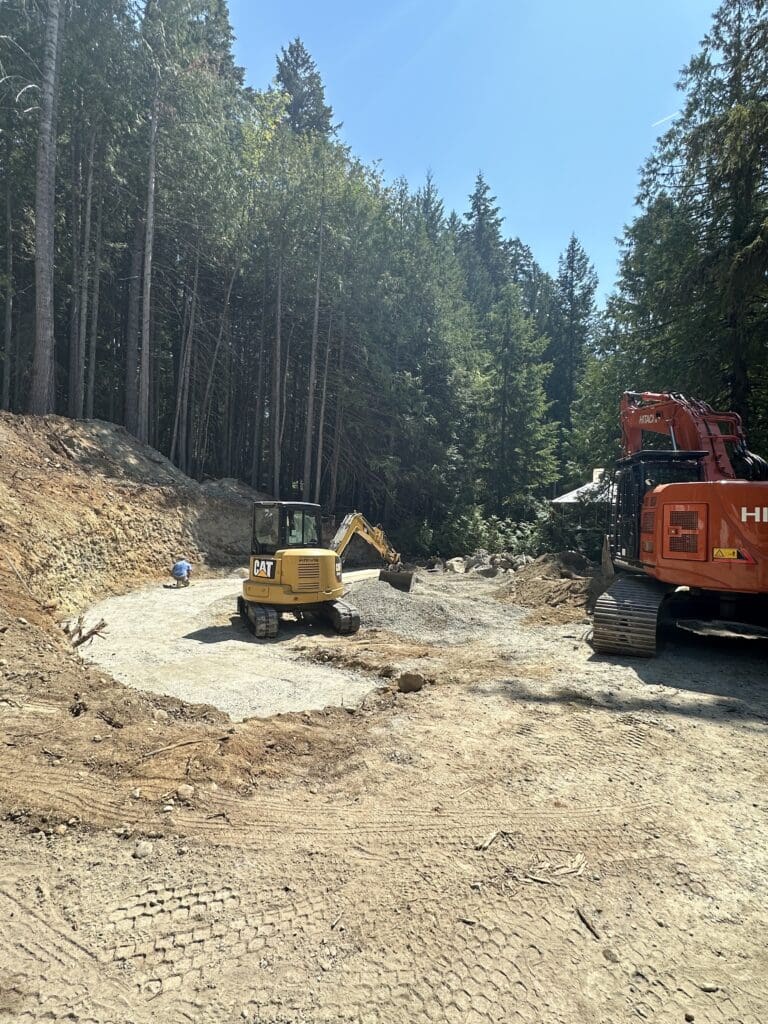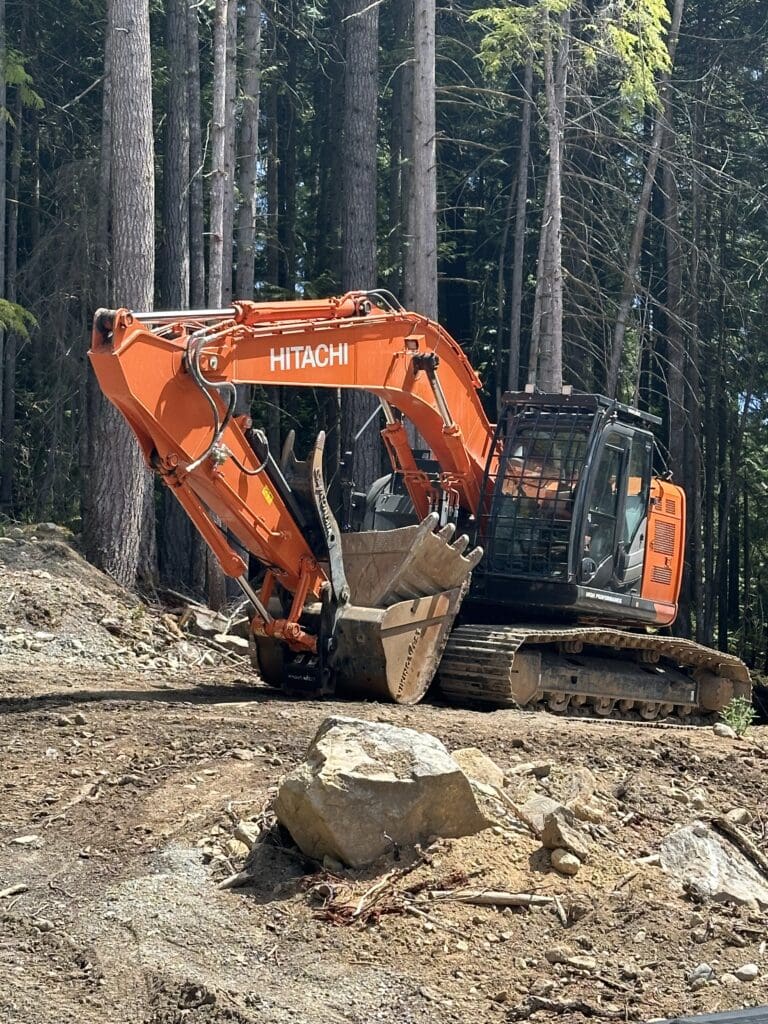
Excavation is one of the most crucial steps in any construction or landscaping project. Whether it’s preparing for a new home foundation, installing a drainage system, or building a retaining wall, proper excavation ensures safety, stability, and long-term structural integrity. In the Cowichan Valley, where soil conditions, slopes, and drainage vary widely, hiring a qualified excavation contractor can make all the difference.
Professional excavation projects involve several distinct stages — from initial site evaluation to the final grading — each requiring precision, experience, and the right equipment for the job.
Excavation is more than simply moving earth; it’s a planned, technical process that combines assessment, precision, and the right machinery to prepare land for construction or landscaping. Each stage of excavation contributes directly to the strength and safety of the finished structure. A properly executed excavation ensures a level and stable base, adequate drainage, and safe access routes for construction activities. It also helps protect underground utilities and maintain separation between different soil types.
Experienced excavation contractors understand soil composition, grading principles, and municipal regulations specific to the Cowichan Valley. This combination of skill and local knowledge ensures every excavation project is performed safely, efficiently, and to code.
Pro Tip:
Always confirm your excavation contractor is licensed, insured, and Red Seal certified. This ensures they follow national safety and workmanship standards while complying with municipal regulations.
Before any machinery begins moving, an in-depth site assessment is conducted. This stage involves soil testing, surveying, and identifying underground utilities.
Reputable contractors coordinate with local authorities and BC One Call to locate and mark existing water, gas, and electrical lines. This minimizes risk and ensures full compliance with WorkSafeBC safety protocols.
During this phase, the contractor will:
Key Takeaway:
Proper assessment prevents costly surprises, such as water pooling, soil collapse, or foundation settlement later in the project.
With plans in place, the next stage involves land clearing. Trees, stumps, rocks, and debris are removed to create a stable work area. Depending on the site, erosion-control measures such as silt fencing or gravel pads may be installed to protect nearby waterways and prevent runoff.
Contractors typically use a combination of excavators, dump trucks, and skid steers to efficiently remove materials while maintaining environmental responsibility. Reusable soil and rock are often repurposed for backfilling or grading later in the project. Recycling and reusing materials from the site not only reduces disposal costs but also supports sustainability by limiting waste sent to landfills.
Taking the time to evaluate which materials can be repurposed helps reduce the need for new aggregates and minimizes environmental impact. This approach aligns with responsible construction practices, ensuring that the site is both prepared and environmentally managed before major excavation begins.
Once the site is cleared, the actual excavation begins. The goal is to achieve precise depths and dimensions that match the structural design.
Professional excavation involves:
Many contractors work closely with engineers to ensure excavation depths meet local building code requirements, especially for foundation and utility installations. Skilled operators are trained to handle varying soil types common in Cowichan — from clay-heavy valley bottoms to rocky uplands.
Key Takeaway:
Precision excavation saves time and money by preventing rework. It also ensures your foundation or retaining wall sits on solid, compacted ground.

After bulk excavation, attention turns to trenching for utilities such as water, sewer, and electrical systems. On many Cowichan Valley properties, drainage is a critical focus because of frequent rainfall and varied terrain. During this stage, contractors create trenches to precise depths and slopes, ensuring efficient flow and preventing any potential backflow.
Proper drainage installation is essential not only for the system’s performance but also for the long-term health of the foundation. Including perimeter drains and stormwater systems at this phase helps manage water runoff and prevents moisture from seeping into basements or crawl spaces. Bedding materials, such as crushed gravel, are placed around pipes to enhance support and ensure consistent flow.
Installing drainage at the same time as the main excavation work reduces future costs and avoids the need for additional digging once the structure is complete. It also minimizes disruptions to the site and ensures that all underground components are correctly aligned and graded before backfilling begins. This integrated approach provides long-term protection against moisture-related issues and maintains the property’s structural integrity.
With trenches and drainage complete, attention turns to shaping the foundation area — a key element in ensuring the structure’s long-term stability. Excavators dig to the required depth, forming level footing trenches according to the engineer’s specifications. Precision is essential here, as even small inconsistencies can affect the building’s load distribution.
Once excavation is finished, concrete forms are set, inspected, and poured. After curing, backfilling begins using compacted layers of soil around the foundation. Each layer is carefully packed to prevent shifting or settling over time. A blend of native soil and gravel is often used to balance compaction with proper drainage.
To further protect against moisture, contractors may install gravel backfill or drainage tile systems that help direct water away from the foundation. Final regrading ensures that surface water flows away from the building, minimizing the risk of erosion or basement leaks.
Key Takeaway:
The backfill process is just as important as excavation itself. Proper compaction and drainage grading ensure long-term stability for driveways, patios, and foundations.
The final step involves fine grading — shaping the ground for optimal drainage, access, and aesthetics. This stage determines how water moves across the property and how the finished surfaces align with structures and landscaping. Driveways, pathways, and garden beds are established with careful attention to slope and stability.
In rural and residential projects, dump trucks may haul in topsoil, gravel, or fill material to complete the finish grade. Proper grading ensures surface water flows away from foundations, protecting basements and crawl spaces from moisture buildup. The recommended slope is a minimum 2% grade — roughly a quarter inch per foot — extending at least two metres from the building perimeter.
Compact grading equipment is often used to smooth out surface irregularities and achieve the desired contour. Contractors also take this opportunity to finalize site access routes, adjust patio or driveway elevations, and prepare the topsoil for seeding or sod installation.
Excavation projects in the Cowichan Valley often take place near creeks, slopes, or sensitive soil zones, which makes environmental protection and safety management essential. Responsible contractors plan each job with measures in place to prevent erosion, control sediment, and protect the surrounding landscape. Dust and noise are monitored and minimized to reduce the impact on nearby residents and ecosystems.
Fuel storage and equipment maintenance are carefully managed to avoid leaks or spills that could harm the environment. Worker safety is a top priority throughout the process, with trained crews following strict site inspection routines and adhering to WorkSafeBC standards.
Every excavation project should comply with provincial and municipal regulations to maintain environmental integrity and ensure the safety of both workers and the community. Proper environmental and safety management contributes to a more efficient project, minimizes disruption, and supports long-term sustainability across the Cowichan Valley.
Working with a local, Red Seal–certified contractor offers major advantages. The Cowichan Valley’s diverse terrain and rainfall patterns require deep knowledge of soil behaviour, drainage, and permitting requirements.
Local contractors understand:
Key Takeaway: Local expertise saves time, reduces risk, and ensures your project meets regional standards from start to finish.
A professional excavation project is the backbone of every successful build. From the first shovel to the last load of topsoil, each stage — assessment, clearing, trenching, foundation, and grading — requires precision and planning.
For homeowners and developers across the Cowichan Valley, hiring a certified excavation team ensures the project starts with the right foundation — both literally and structurally. Thoughtful planning, precise execution, and adherence to safety standards ensure that the work completed below the surface supports everything that follows above it. With proper excavation, every build gains the stability, efficiency, and longevity it needs to stand the test of time.
Most residential excavation projects in the Cowichan Valley take between 2 and 7 days, depending on soil conditions, weather, and project size.
Yes. Projects involving foundation work, drainage, or major land alteration typically require municipal permits. A professional contractor can help with the paperwork and ensure compliance.
Usable soil is often stored for backfilling or landscaping, while excess material is safely disposed of or recycled in accordance with local regulations.
Yes, but it depends on the weather and soil conditions. Frozen or overly wet ground can affect efficiency and safety, so contractors often plan major excavations in drier months.
Look for experience, local references, Red Seal certification, and insurance coverage. It’s also wise to choose a company that offers both excavation and hauling services for complete project support.
